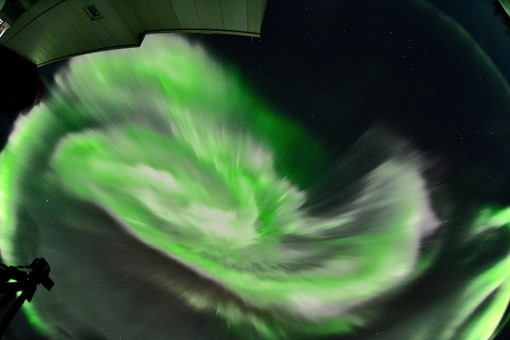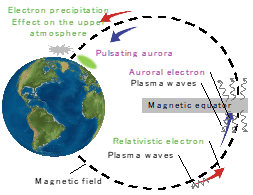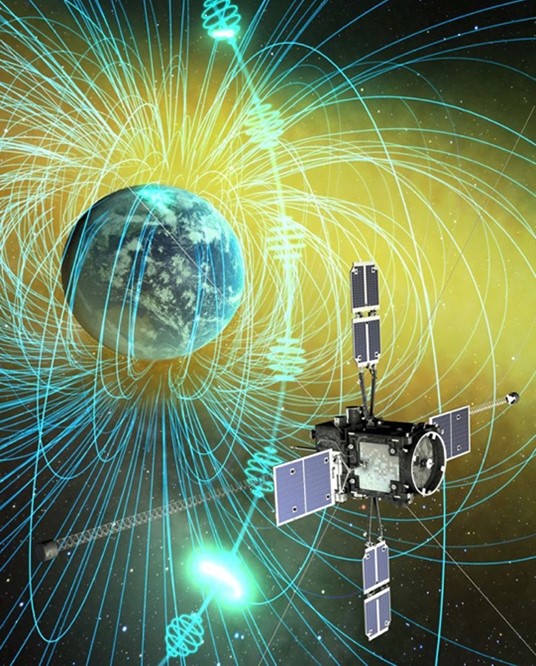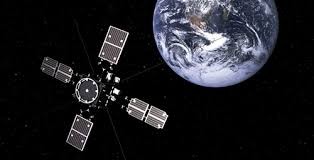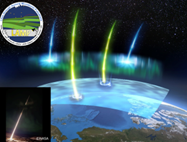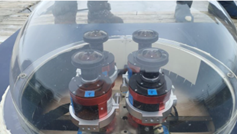Earth
We observe auroral emissions from both space and ground, and combine them with satellites and ground-based radar to promote a comprehensive understanding of auroral physics.
Certain types of auroras are of interest because of the very high energy precipitating electrons that affect the middle atmosphere. We launched the LAMP rocket in 2022, the first in the world to successfully observe these phenomena simultaneously. We also plan to launch the LAMP-2 rocket.
On the other hand, the high-latitude polar cap region, which is directly affected by the solar wind, is attracting attention from the perspective of space weather. We have developed 10 all-sky cameras and constructed an observation network that covers a wide area over the Antarctic Continent. Written by SAKANOI, Takeshi.
‘Geospace’ is the space around the Earth that consist of plasma (charged particles) originating from the Earth’s atmosphere and the solar wind. The electromagnetic waves propagating in the plasma are called ‘plasma waves’. In space, collisions between particles rarely occur, but the motion of particles is scattered by ‘collisions’ between plasma waves and charged particles. As a result, the enegetic particles precipiatte into the Earth’s atmosphere and cause polar auroras and affect the composition in the upper atmosphere. Therefore, studying the generation and propagation of plasma waves is important topic for understanding the connection between space and the Earth’s atmosphere. Using observations of plasma waves by the Arase satellite and groundbased aurora observations, we are investigating how plasma waves propagate through geospace and scatter enegetic charged particles, and studying the effects of space on the Earth’s atmosphere. Written by TSUCHIYA, Fuminori.
“Have you heard that “Earth is like a giant magnet”? This magnet creates a vast region called the magnetosphere, which acts like a protective shield from the stream of charged particles known as the solar wind.
I study what’s going on inside this magnetosphere—especially what kinds of ions (electrically charged particles) are there, where they are, and how many of them exist by analyzing lectromagnetic ion cyclotron (EMIC) waves. Right now, I’m working with data from the Arase satellite to try to uncover the types and ratios of ions present in the magnetosphere.
This could also help us study other planets. For example, BepiColombo is scheduled to arrive at Mercury in 2026, and JUICE will begin orbiting Jupiter in 2031. By applying this method, we hope to open new ways to explore planetary magnetic fields and plasma environments across the solar system.” Written by KIKUCHI Riku.
Auroral Kilometric Radiation (AKR), a type of auroral radio emission from Earth, is closely associated with various phenomena and structures in the Earth’s magnetosphere. It serves as a valuable barometer for understanding the state and dynamics of the magnetosphere.
However, long-term statistical studies of AKR—particularly those focusing on its correlation with solar activity—have been limited.
In this study, I aim to conduct a long-term statistical analysis of AKR using data from the Geotail satellite, which has observed the Earth’s magnetosphere for nearly 30 years.
By clarifying the occurrence characteristics and temporal variations of AKR, I hope to contribute to a deeper understanding of the Earth’s magnetospheric environment. Written by YAMANAKA Haruto.
Since 2017 the Arase satellite has been investigating electron number density and temperature in the near-Earth environment. Electron density is derived from the upper-hybrid resonance (UHR) frequency recorded by the onboard electric-field antennas, yet this technique tends to underestimate density in low-density regions. To address the bias, we integrated satellite potential, in-situ particle measurements, and solar UV flux, and compared the resulting data set for 2017–2022. The analysis shows that, under geomagnetically quiet conditions, satellite potential and electron density exhibit a clear proportional relationship, with an additional dependence on electron temperature. These findings reduce measurement uncertainties and will enhance the accuracy of plasma observations by BepiColombo/MMO, scheduled to explore Mercury in 2026. Written by KAWAGATA Keiya.
ARASE is developed by the Japan Aerospace Exploration Agency (JAXA) to explore “geospace”, the space around the Earth. It was launched in December 2016 to explore the radiation belt (Van Allen belt), a region around the Earth where high-energy particles are trapped by Earth’s magnetic field, and the electromagnetic waves and plasmas which involved in the acceleration and loss of radiation particles. Since the radiation belts can have impacts on human activities in space, ARASE aims to investigate the generation process of high-energy particles in space, as well as to promote space weather research to predict the space environment.
Tohoku University has been involved in the development of the Plasma Wave Experiment (PWE) onboard the satellite and the construction of a ground-based observation network to observe auroras and electromagnetic waves in cooperation with ARASE.
ISAS Arase project
Nagoya University ERG science
Illustration by JAXA
FACTORS is a future formation flight satellite mission at an altitude range up to thousands of kilometers of Earth’s polar regions. The space environment in this region is characterized by inter-regional connections that manifest themselves on diverse temporal and spatial scales, as exemplified by the small-scale complex structures of auroras. This environment involves the acceleration and transport of space matter, the excitation and propagation of waves associated with these processes, and the formation and interaction of electric field and current structures. These phenomena are considered fundamental and universal mechanisms for the formation of magnetospheres and atmospheric evolution in magnetized planetary systems.
FACTORS will consist of instruments measuring magnetic field, electric field, and plasma particles, as well as auroral cameras developed by PPARC. Utilizing the experience gained from cameras installed on the Reimei satellite and LAMP rockets, these cameras plan to observe the fine structures of auroras at two wavelengths, visible and ultraviolet.
Pulsating aurora is one type of aurora which variates with a period of several seconds. Recently, it has been hypothesized that when the pulsating aurora occurs, high-energy electrons with energies of several hundred kiloelectron volts or more, called “killer electrons,” also precipitate at the same time. These “killer electrons” can penetrate to the middle atmosphere at low altitudes of tens of kilometers and may destroy the ozone.
We started the discussion with American researchers in 2015 and proposed the LAMP rocket experiment to NASA. PPARC was responsible for the development of the two onboard cameras to observe aurora from space. The rocket successfully launched and observed the pulsating aurora immediately after a significant auroral breakup from Poker Flat, Alaska, on March 5, 2022. This observation revealed a one-to-one correspondence between killer electrons and pulsating auroral emission precisely for the first time in the world.
Based on this achievement, we are now preparing for the next LAMP-2 rocket experiment, which is planned to enhance the linkage with ground-based radar and optical observations.
Multi-wavelength observations of ground-based all-sky cameras are important for understanding the morphology and other characteristics of the aurora. National Institute of Polar Research (NIPR) is conducting the Phase X Research (Aurora X Project: FY2022~27). In the polar cap region, direct interaction between the solar wind and the atmosphere occurs, resulting in electron and ion precipitation over a wide energy range from several hundred eV (solar wind) to MeV (SEP).
We developed 10 all-sky cameras for this project: four at Syowa Station starting in 2023, two each at Casey and Davis Stations of Australia, and two each at Dumont d’Urville and Concordia Stations of France and Italy in 2025. In addition, the Arctic Scandinavian cameras in 2024.
We also started low-latitude aurora at Iitate observatory of PPARC since 2024.
OCTAVES (Observation of CondiTion of ionized Atmosphere by VLF Experiment) is a VLF/LF ionosphere observation network that measures modification of electron density in the lower ionosphere. Low frequency (LF) and very low frequency (VLF) radio waves propagate between earth’s surface and lower edge of ionosphere (70-90km, approx.) at long distance.
As modification of the lower ionosphere causes changes in received signal amplitude and phase, LF/VLF radio observation is a useful probe to detect variation of electron density in the lower ionosphere.
Scientific targets of this network includes (1) Energetic particle precipitation from radiation belts, (2) Lightning effects on upper and middle atmospheres, (3) Solar X-ray flare and proton event effect on upper and middle atmospheres, (4) Effects of solar eclipse, atmospheric gravity waves, and sound wave on the lower ionosphere, and (5) Detection of gamma ray burst.








